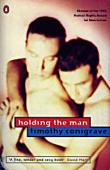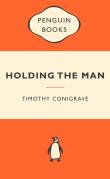AustLit
Latest Issues
AbstractHistoryArchive Description
'The mid-seventies - and satin baggies and chunky platforms reigned supreme. Jethro Tull did battle with glam-rock for the airwaves. At an all-boys Catholic school in Melbourne Timothy Conigrave fell wildly and sweetly in love with the captain of the football team. So began a relationship that was to last for fifteen years, a love affair that weathered disapproval, separation and, ultimately, death. Holding the Man recreates that relationship. With honesty and insight it explore the highs and lows of any partnership: the intimacy, constraints, temptations. And the strength of heart both men had to find when they tested positive to HIV.' (Publisher's blurb)
Adaptations
-
y
 Holding the Man
2006
London
:
Nick Hern Books
,
2010
Z1232414
2006
single work
drama
Holding the Man
2006
London
:
Nick Hern Books
,
2010
Z1232414
2006
single work
drama
-
form
y
 Holding the Man
( dir. Neil Armfield
)
Australia
:
Goalpost Pictures
,
2015
7793845
2015
single work
film/TV
Holding the Man
( dir. Neil Armfield
)
Australia
:
Goalpost Pictures
,
2015
7793845
2015
single work
film/TV
'In the 1970s, a young Australian boy, Timothy, finds himself confused. He falls for the captain of the football team. What follows shows all aspects of a relationship, regardless of gender or sexual preference. Conflict, temptation, and a huge burden which will affect every aspect of their lives.' (Production summary: IMDB)
Notes
-
Epigraph: Life is nothing if not change. - my friend Laura
Affiliation Notes
-
Writing Disability in Australia:
Type of disability HIV/AIDS. Type of character Primary. Point of view First person (autobiographical).
Publication Details of Only Known VersionEarliest 2 Known Versions of
Other Formats
- Also sound recording.
- Also e-book.
Works about this Work
-
What I’m Reading
2018
single work
column
— Appears in: Meanjin Online 2018; -
Their Time in Memorial : Nickolas Bird and Eleanor Sharpe's Remembering the Man
2016
single work
essay
— Appears in: Metro Magazine , Winter vol. 189 no. 2016; (p. 110-115)Released mere months after the premiere of Holding the Man – the lauded film adaptation of Timothy Conigrave's memoir of the same name – Remembering the Man offers new insights into Conigrave's relationship with John Caleo through interviews and archival footage. Beyond being a mere companion piece, the documentary provides a more compelling account by chronicling the wider world surrounding the couple's romance, writes Laurence Barber.
-
form
y
 Remembering the Man
( dir. Nick Bird
et. al. )agent
2015
9234059
2015
single work
film/TV
Remembering the Man
( dir. Nick Bird
et. al. )agent
2015
9234059
2015
single work
film/TV
'At an exclusive Catholic boys school in Melbourne 1976, Tim Conigrave and John Caleo fell madly in love. Their passionate, tempestuous, operatic romance lasted for 16 years, facing disapproval, temptation, separation, and the looming shadow of the Grim Reaper. Their relationship has been immortalised in Conigrave's posthumous autobiography Holding the Man (now a major Australian film directed by Neil Armfield). This is the true story of how Romeo met Romeo and how first love can not only last but endure.' (Source: Screen Australia website)
-
Shelf Life : Holding the Man
2015
single work
column
— Appears in: Good Reading , October 2015; (p. 16-17) -
Sam Holding Aussie Book
2015
single work
column
— Appears in: The Advertiser , 8 May 2015; (p. 30)
-
Holding the Man : Tragedy and the Literature of AIDS
2002
single work
criticism
— Appears in: 'Unemployed at Last!' : Essays on Australian Literature to 2002 for Julian Croft 2002; (p. 187-209) The object of this article is 'to examine the possibility of a revival of tragedy manifested in a certain sector of contemporary writing': books that are the product fo the AIDS epidemic. After a general introductory section on tragedy and humanism, it extensively discusses Conigrave's autobiography Holding the Man (1995) under the aspect of the concept of tragedy. -
Aids, Fragile Love and Dying
2003
single work
column
— Appears in: The Sunday Age , 28 September 2003; (p. 10) -
Pieces of a Life, in Their Hands
2006
single work
criticism
— Appears in: The Sydney Morning Herald , 30 October 2006; (p. 14) -
Playwright Hears Voice from the Past
2006
single work
criticism
— Appears in: Quarterly : Sydney PEN Centre , November no. 126 2006; (p. 12) -
Australian HIV/AIDS Life Writing
2011
single work
criticism
— Appears in: Out Here : Gay and Lesbian Perspectives VI 2011; (p. 104-119) 'In Australia, AIDS life documents encompass a variety of forms and narrative styles,including quilt panels, interviews, articles by people living with HIV and AIDS, diaries, photographs and documentary film - as well as art, music and fiction. this study will only document and analyse a fraction of these materials, focusing on public writings. the texts examined here are mainly 'traditional' book-length life narratives, supplemented by one documentary film and two diaries. Other materials, including collections of interviews and shorter biographical works on people with HIV/AIDS, have not been excluded except when they directly contribute to the discourse as part of an emerging pattern during the last decade.' (From author's introduction p.105)
Awards
- 1995 winner United Nations Prizes in the Field of Human Rights — Non-Fiction
- 1995 winner Human Rights Awards — Literature Non-Fiction Award
- Melbourne, Victoria,
- Sydney, New South Wales,
- ca. 1975-1995




